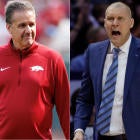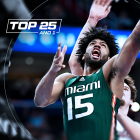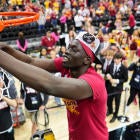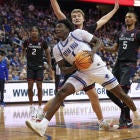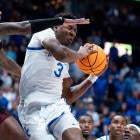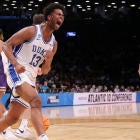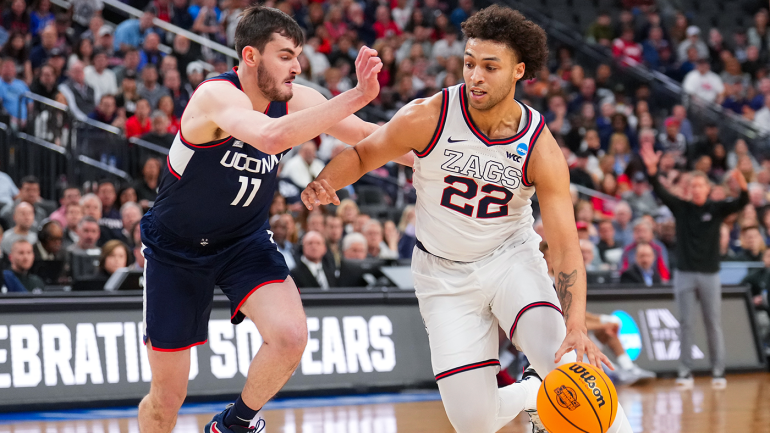
Any doubt about Gonzaga being a basketball blue blood may have been dispelled the moment Jeff Nelson opened his laptop last week to reveal proprietary information regarding the latest round of realignment.
Nelson is the president of Navigate, a respected Chicago-based consulting firm used by several conferences to aid in their realignment efforts over the years. Navigate is presently working with Gonzaga on a possible move to the Big 12 or Pac-12.
Navigate evaluated how the nation's top basketball programs ranked against power-conference opponents in regular-season play over the last three years with a metrical called "TV Power."
Gonzaga is a surprising fifth on that list. It sits behind Duke, Kentucky, North Carolina and Kansas but ahead of Ohio State, Michigan, Michigan State, Arkansas and Tennessee, which rounded out the top 10.
Blue blood? Gonzaga? Small sample size? All of it is still up for debate, but the Zags' worth is reflected in the Big 12's shift of priorities. While the league's interest in recruiting Pac-12 teams remains, adding Gonzaga (basketball only) and UConn (full membership) is dominating league conversations.
The Big 12 continues to wait for the Pac-12 to reveal a new media rights figure to its members before taking the next step in that pursuit. Meanwhile, the league has been more aggressive lately in pursuing their basketball interests, especially after last week's Big 12 spring meetings.
Commissioner Brett Yormark reiterated that expansion had been discussed. The situation was further described to CBS Sports this way: There has been "mutual admiration" at the presidential level between Gonzaga and the Big 12; however, there is stronger "momentum" for UConn to join the league than Gonzaga at the moment.
"We're going to consider all options," Yormark said. "We do see the upside in basketball for all the right reasons. We think it is undervalued and there is a chance for us to double down as the No. 1 basketball conference in America, but football is the driver. We all know that."
It's no secret Yormark has a distinct, long-term basketball vision, one that ultimately includes separate media rights contracts for basketball and football. That's never been done, at least in the modern era of the Power Five. Basketball has always lagged behind in valuation with the football being the primary revenue generator.
Yormark believes, with the interest of streaming properties on the rise, college basketball will be worth more to more suitors in the future. There are those in the industry who disagree. One key issue: Any movement in separating media rights would have to wait at least seven years until the Big 12's new media rights deal expires in 2031.
That wouldn't preclude the Big 12 from adding two national hoops powerhouses to what is already the No. 1 college basketball league. Either addition would play into Yormark's stated intent of making the Big 12 "younger, hipper and cooler."
Gonzaga has received a $15 million annual valuation, per one industry source, should it join a Power Five conference for basketball. That's less than half of what full-ride Big 12 members will receive ($31.7 million) beginning in 2025. The figure attached to UConn is less clear in that basketball would be central to any deal accompanied by a lowly regarded football independent.
It's safe to say the addition of such a unique pair of national basketball programs as expansion candidates has seldom -- if ever -- been attempted in the Power Five era.
The feeling locally regarding a UConn move has been described as mixed.
On one hand, migration to the Big 12 would cause the school to lose its identity; it would be losing at least some ties to the Northeast and Big East rivals to play in such far-flung outposts as Stillwater, Oklahoma, and Ames, Iowa.
UConn, entering Year 4 in its return to the Big East, would reportedly owe the conference at least $30 million in exit fees if it departed before its seventh year as a member. That's for an athletic department reportedly $53 million in the red already.
The Huskies are a snapshot themselves of realignment. Prior to this year, their last national championship was achieved in 2014 as a member of the American where they played with two of the Big 12's four most recent expansion teams: Houston and UCF.
The Big East has regained a lot of its old swagger and respect because UConn is a member. With Georgetown (Ed Cooley) and St. John's (Rick Pitino) adding significant coaches this offseason, the league has gotten even stronger. One veteran Big East source even suggested a move to the Big 12 would not only enable suitors to come after UConn coach Danny Hurley, the coach might even begin looking elsewhere himself.
On the other hand, well, there's that Big 12 money. Per a 12-year deal signed with Fox in 2012, the 11-team Big East averages $42 million annually or $3.8 million per school. (UConn left the Big East for the American in 2013 and returned to the Big East in 2020.) The Big 12 just distributed $440 million in total revenue to its 10 members for 2022-23 fiscal year, an average of $44 million per school. Though again, that is powered by football rights.
UConn wouldn't get that anytime soon, but think of any new additions to the Big 12 as a growth stock if handled the right way. With the SEC and Big Ten dominating college athletics, the idea may be to round up as many brands as possible to become a solid No. 3 conference in the pecking order. That matters in terms of security, finances and access to both the NCAA Tournament and College Football Playoff.
In the end, the Big 12 may appeal to UConn's sensibilities. In the realignment merry-go-round, the school has seldom been courted like this. Yormark is a Northeast guy with big ideas and extensive ties to New York.
His league is already considering a series of exhibition basketball games in New York's famed Rucker Park next summer. Think of Kansas, Baylor, UConn and Gonzaga taking part. That's the last three national champions plus a Zags team that has twice played for the national title since 2017 and been to eight consecutive Sweet 16s.
A developing mystery becomes who would pay for Gonzaga and UConn. It's highly unlikely Fox or ESPN would want to reopen a Big 12 deal that has yet to begin, especially with the Zags as a basketball-only member. Financially, UConn's football would almost be an afterthought in the Big 12, which indicates how much Yormark values basketball to make the move.
Sources tell CBS Sports that the money, at least for Gonzaga, would more than likely come from within the league. Schools might sacrifice some of their existing share to entice the Zags and/or Huskies. Plus, the Big 12 continues to sit on the $100 million combined buyout it got from Texas and Oklahoma.
That's where Navigate gets involved determining Gonzaga's valuation to a new league. There are qualifiers. UConn -- with its five national championships -- is No. 38 in that TV Power metric. And for all its national appeal, Gonzaga has played less than 20 regular-season games against power conference competition over the past three season. (Michigan State, No. 8 in TV Power, has played 71.)
That plays into Gonzaga's interest in moving up in class. It considers itself equals on the court with those traditional blue bloods. It's no secret the Pac-12 -- a much better geographic fit for the Zags -- is making a considerable pitch despite its current state.
Typically, basketball is worth 15% to 20% of a Power Five media rights deal. In the Big 12, that would amount to around $5 million or $6 million. The question: Could Gonzaga command more than that share as a standalone national power to the Big 12 or Pac-12?
If Gonzaga was to negotiate based on that $15 million annual valuation, the Big 12 would be seeking $1.25 million from each of its members. (BYU, Cincinnati, Houston and UCF are joining on a graded scale and won't have immediate full shares.)
Since 2019 when the Mountain West courted Gonzaga, the Zags have earned a weighted share of WCC revenue. And for good reason. They have accounted for more than 70% of the "units" accrued by the WCC since 1999. Teams in the NCAA Tournament earn those units for each win.
The WCC earned six units from the 2023 tournament totaling $12 million, according to Sportico. The Big 12 was second nationally behind the SEC with 16 units worth $32 million. The Big East was third with 15 units and $30 million.
Those units represent the large majority of the WCC's revenue. It has TV deals with ESPN and CBS Sports Network. Four years ago, when the MWC showed interest, Gonzaga had leverage having forged something close to that blue blood status. It has made the tournament 24 straight seasons not counting the 2020 COVID-19 year.
"It wasn't easy by any stretch," former Gonzaga athletic director Mike Roth said of the weighted revenue split. "It was different. There were some within the conference who said, 'Nobody else does it this way.' From the Gonzaga side of the conference, my comment was, 'Yeah but nobody has somebody in a conference doing what Gonzaga has done.'"
"All of the sudden, the West Coast Conference, we were kind of out in front of what others are talking about doing. I know the Pac-12 is having the same discussions [regarding weighted shares]. It's worked extremely well for the conference."
In going to the Big 12, Gonzaga and UConn would have to leave behind those units earned in their old leagues. Obviously, there are bigger considerations. The Power Five conferences each earned $80 million in College Football Playoff funds alone, basically just for being Power Five conferences.
Gonzaga skews younger, according to Navigate's research, attracting an audience outside of its natural footprint. UConn's fan base is more localized. Navigate's metrics show that Gonzaga's ratings against power opponents are 2.5 times higher than an average Big 12 game. Since 2017, Gonzaga has the highest win percentage against power teams at 78%.
There are travel partners to go with both possibilities. If the Big 12 is able to land Colorado, that would give it three members in the Mountain Time Zone, along with Gonzaga and BYU. (Gonzaga does not sponsor football. Its minor sports would also be in the Big 12.)
Would UConn be persuaded with more Big 12 money and "nearby" teams in Cincinnati, West Virginia and UCF?
All of it might depend on your definition of younger, hipper, cooler.














